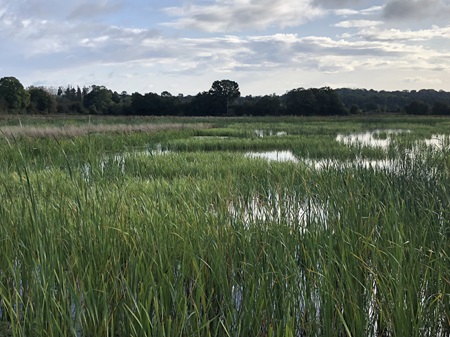Luston Integrated Constructed Wetland (ICW)
The River Wye is struggling with high levels of phosphorus entering the watercourse and altering its delicate ecological balance. It is designated as a Special Area of Conservation (SAC), an international designation because of its special features and protected species including crayfish, salmon and otter.
Currently both the River Wye and the River Lugg are classified by Natural England as being in unfavourable condition and because the River Lugg SAC is exceeding its targets for phosphates, all new development within the Lugg catchment, is required to demonstrate nutrient neutrality.
With nutrient neutrality requirements in place from 2019, housing development halted in north Herefordshire while awaiting a solution. The Luston wetland funded by Herefordshire Council and the Local Enterprise Partnership (LEP) contributes to river betterment as well as providing mitigation in the form of phosphate credits, enabling planning permissions to be granted and over 1,000 new homes in the catchment to be built.
Constructing Luston wetland
Integrated wetlands
The Integrated Wetlands project is the council's innovative natural solution to nutrient management. The wetlands will address point source pollution by taking treated water from Welsh Water treatment works and diverting its flow through the wetland for phosphate removal.
The wetland has been planted with a variety of native species that have the ability to take up large amounts of phosphate from water. The phosphate is used by the plants for growth and can be stored in the roots, thereby reducing the quantity of phosphate in the water before it re-enters the watercourse.

Planting by hand at Luston.

The Luston site as it first became operational and water was switched on.
This project is the first of its kind - modelling undertaken on the Luston wetland identified that the site will remove 291.2 kg phosphate per year, of this 58.2 kg per year will be used for river betterment with the remainder used to enable economic growth in the county.
Now that the wetland is operational, weekly testing is underway to monitor the phosphate removed from the water and phosphate credits are being made available to developers to purchase to offset the phosphate load of their new development.
We are pursuing further wetland sites across the county to enable future growth. Two sites at Tarrington and Titley have planning permission, with further sites also under consideration.

A simple diagram cross section of a horizontal flow wetland. This diagram was AI generated.
Luston biodiversity
Wetlands function as their own distinct ecosystem and have many benefits in addition to being able to remove phosphate effectively. They are able to remove a variety of nutrients and pollutants and are also a carbon sink, providing new habitat rich in biodiversity.
The site at Luston once an agricultural field low in ecological value has now been turned into a natural asset enhancing the local landscape and providing a new biodiversity haven. Assessment based on the Biodiversity Net Gain Metric, indicates Luston has an expected 183% increase in biodiversity value.
Already several new species have moved into the site and initial surveys show it is now providing habitat for a variety of wildfowl, bat, and insect species. As the site is being managed as natural habitat, we hope to see skylark, newts, and a large array of invertebrates and mammals making Luston their new home in the near future.

Luston at the start of autumn 2023 as plants continue to thrive in the wetland cells.
Read more about Luston and the wonderful species that have been planted in the Luston case study.
Wetland delivering 68% total phosphorous reduction
Initial data from Luston wetland shows average reductions in total phosphorous levels of 68%.
Since the site became operational in July 2023, the council's Ecology Team have undertaken weekly monitoring of the site. Samples are collected at the inlet and outlet of the wetland to enable comparisons of nutrient levels and assess the wetland's effectiveness. At the inlet, water flows from the nearby treatment works. Whereas samples from the outlet have travelled through each of the wetland's three cells.
Independent monitoring undertaken from November 2023 to June 2024 has evidenced an average reduction in total phosphorous by 68%. This figure is based on concentration variations between the inlet and outlet. This demonstrates the high degree of efficiency with which the wetland is removing total phosphorous from the watercourse. The wetland is a nature based solution and as the aquatic plants in each cell become more established the capacity to absorb nutrients is increased and reductions will be expected to rise. However, early indications of total phosphorous reductions are encouraging. Pre-build monitoring of the site focused on the ability of the wetland to reduce the load of total phosphorous between the inlet and outlet.

The graph depicts inlet and outlet values of total phosphorous values. Results are shown from November 2023 to June 2024. As the months progress the difference between inlet and outlet values widens, as inlet levels increase and outlet values decrease.
